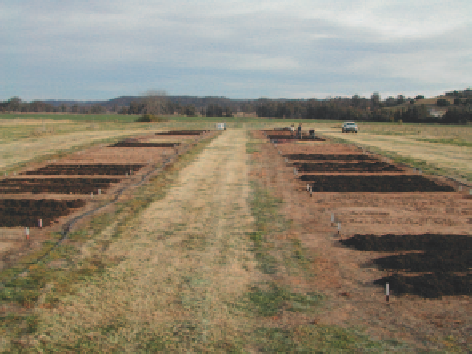Agriculture Reference
In-Depth Information
Fig. 7.4
The garden organics
compost (cGO) being spread
out on the compost treatment
plots prior to incorporation
into the soil with a rotary hoe,
prior to the planting of crop
6—capsicum, at the CROA
field experiment site
duration of the crop. Poultry manure was applied with P for treatments T1 and T4
and incorporated into the soil prior to the planting of each crop.
The compost was applied to the compost treatments in a single application prior
to the first crop. The full compost application rate for treatments T2 and T5 was
determined to be 125 dry t ha
−1
based on the recommended agronomic rate for N
for the first crop (broccoli), the total N content of the compost, and the availability
index of 0.10 for compost (Evanylo and Sherony
2002
). The half compost rate for
treatments T3 and T6, was, therefore, 62.5 dry t ha
−1
. For the full compost treat-
ments (T2 and T5), urea was only applied when petiole sap test results confirmed
crop observations of low nitrate levels compared to the farmer practice treatments
(T1 and T4). Applications of inorganic N fertilizer were not required for the first
two crops of the full compost treatments (T2 and T5), but were required for crops
3 to 5. The full compost treatments received no muriate of potash over the course
of the trial. The inorganic chemical and organic fertilizer inputs for each treatment
for each of the first five crops is summarised in Table
7.2
. Following the first 5 veg-
etable crops, a repeat application of compost was applied to the compost treatments,
and a further 5 crops were grown. For the purpose of the following discussions,
treatments T1 and T4, T2 and T5, T3 and T6, and T7 will be referred to collectively
as 'farmer practice', 'compost', 'mixed' and 'control' treatments respectively.
The cropping sequence for this experiment was; 1. Broccoli (
Brassica oleracea
var.
botrytis
L.), 2. Egg-plant (
Solanum melongena
L.), 3. Cabbage (
Brassica ol-
eracea
L.), 4. Capsicum or bell pepper (
Capsicum annuum
L.), 5.Leek (
Allium am-
peloprasum
var.
porrum
L.), 6. Capsicum or bell pepper ('
Capsicum annuum
L.'),
7. Broccoli (
Brassica oleracea
var.
botrytis
L.), 8. lettuce (Lactuca sativa var.
capi-
tata
), 9. Cabbage (
Brassica oleracea
L.) (Figs.
7.5
and
7.6
), and 10. Sweet corn (
Zea
mays
) (Fig.
7.7
). After the harvesting of each crop, all of the non-harvestable crop
residues on each plot were incorporated into the soil by rotary hoeing. Crops were
managed following recommendations from the NSW Department of Primary Indus-
tries (Agfact/Primefact Series
2013
) and an industry handbook (Salvestrin
1998
).

